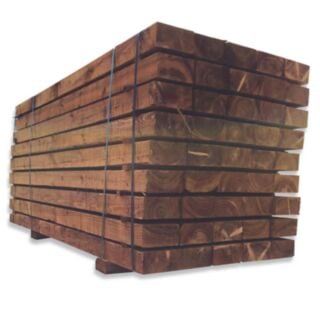Railway sleepers 101: How to Choose the Right Landscaping Sleepers For Your Garden
Buying railway sleepers for your garden can be a daunting task. There are so many options and it's hard to know what to look for when you're shopping.
Choosing the right type of sleeper can be difficult and confusing. There are so many different types of sleepers on the market that it's hard to know which one will work best for your needs.
This guide will walk you through all the considerations you need to make when choosing railway sleepers for your garden. We'll cover everything from material options, installation tips, and more! By reading this article now, we hope you'll have an easier time picking out the perfect set of railway sleepers for your next project
1) Railway sleeper types:
There are many types of materials you can use for your garden. So it's important to know which type of sleeper will work best for your needs. The most common options are hardwood, softwood, and reclaimed sleepers.
Softwood Sleepers
Softwood sleepers are a popular choice for garden landscaping projects. They're often used as retaining walls, beds, and pathways. They are much more affordable than hardwood options. This type of sleeper is made from softwood trees like pine or cedar. It's often the best choice for homeowners who are looking to install railway sleepers around their home.
Softwood sleepers are lighter than hardwoods, which makes them easier to transport and work with onsite. Softwood Sleepers are typically pressure-treated as well. This makes them perfect for exterior landscaping projects like pathways, patios, and gardens. The added weatherproofing means they won't rot or warp over time.
Hardwood Sleepers
These are the traditional type of railway sleeper that has been used throughout history. They're made from durable hardwood trees like teak, Douglas fir, oak, and jarrah.
Hardwood is the most expensive type of sleeper to buy. It's also the heaviest option available on the market. That can make it difficult to transport and install in some cases. But if you're looking for the most durable material possible for your garden project, this is the right option for you.
Reclaimed Sleepers
This is another type of hardwood sleeper that's been reclaimed from an old railway. These sleepers are usually obtained through salvage companies and can be found in your local area. They're usually priced more expensively than options made from new wood. But they offer a lot of character and history that other types of hardwood sleepers just can't beat.
2) Choosing the Right Size Sleeper:
As you're considering which type of sleeper to buy, you'll also need to choose the right size for your needs. Most sleepers are available in standard sizes like 2.4m length with 200mm x 100mm thickness.
You can also find a few odd sizes to choose from, but you should be aware that not all sleepers are available in every size. This means you'll need to buy enough sleeper for your whole project at once. That makes it especially important to know exactly which sizes the suppliers have before going shopping
3) Popular landscaping sleeper finishes :
When you're picking out the perfect sleeper to use for your garden project, you'll also need to think about how it will look. Most sleepers are available in different finishes. The most common types are listed below:
Natural Sleepers:
These sleepers have a really rustic look to them. They'll have all the natural characteristics of the wood used to make them. You can find railway sleeper planks that have been left untreated, or you could opt for a darker version that's been conditioned with a stain, oil, or paint.
Rough Sawn Sleepers:
Rough sawn sleepers are another option for landscaping projects. They'll have more visible character and can feature knots, cracks, and other unique features that add more texture to your garden design. This is the perfect choice if you're looking for a modern appearance with minimal effort or maintenance.
Sawn Sleepers
If you're looking for a sleeper finish that's smooth and even, sawn sleepers are the best choice. They won't have any of those unique features or cracks. But they also won't need as much upkeep as rough sawn sleepers will.
Smooth Sleepers
This is another option for finished railway sleepers. This sleeper finish looks sleek and modern. It's smooth, so it won't have much character anymore. But it also means there are no knots or cracks to worry about. You can find railway sleepers in this finish in the same sizes as rough sawn options are available though.
Frequently asked questions
- What are the best sleepers to use in the garden?
The best sleepers to use in your garden are softwood options like pine or cedar. While they won't be as durable as hardwood sleepers, they'll work well for landscape projects. You can also opt for an old-school recycled railway sleeper if you're looking for something more unique too.
- How do I know what size sleeper to buy?
The best way to figure out what sizes of sleepers you need for your project is to measure the area where you'll be using them. Write down the length and width of the garden space. Then, find out how thick your railway sleepers are so that you can buy enough to fill out all parts of your garden bed.
- Can you lay garden sleepers on soil?
Yes, you can lay railway sleepers directly on top of the soil in your garden. This is a common practice for creating landscape beds. This is a fast and easy method for adding landscaping style anywhere in your garden.
- What do you lay garden sleepers on?
Garden sleepers can either be laid on concrete, sand or gravel foundations. But if you'd prefer to lay them on the soil directly, you can put down a waterproof sheet under the sleepers to avoid them soaking up moisture from the soil.
- Will railway sleepers rot in the ground?
Like all wood, sleepers will eventually rot and fade when exposed to the weather.
But if you use high-quality, pressure-treated softwood sleepers, they can last for years to come.
- What are raised garden beds?
Raised garden beds are a common landscaping project. They create elevated rows of outdoor bedding that make it easier to access your homegrown greens and flowers. Raised beds also drain water more easily than flat ground
- Which sleepers last longest?
The best way to create a long-lasting landscape feature in your garden is to buy railway sleepers that are pressure-treated. This means they've been infused with wood preservatives inside the timber. It's the best protection for making them last longer against rot, decay, moisture, and other weather elements. Treated softwoods can last up to 30 years if properly cared for.
The best sleepers are ones that are FSC-approved. You can find railway sleepers in a variety of different styles, sizes, and conditions.. This means they've been sourced from sustainably managed forests. The most durable sleeper for landscaping projects is a hardwood option. These are more expensive than treated softwood so you'll have to decide if it's worth the extra cost.
- What does FSC-approved mean?
FSC stands for Forest Stewardship Council. It's an organization that monitors how forests and timber are sourced and used across the world. Their goal is to make sure any wood or timber has been produced ethically and naturally. If you see a product that's FSC-approved, it means the wood has been sourced responsibly to support sustainable forestry practices.
- How long will treated softwood sleepers last?
Treated softwood sleepers are the best choice for any landscape project around your home. Treated sleepers will last for decades if they're cared for properly, but you need to make sure that the product is high-quality too. Some cheaper products won't be pressure treated to the same standards, so always check before you buy!
- Are treated pine sleepers safe for vegetable gardens?
Yes, timber that's pressure treated with Tanalith E preservatives will be safe to use in vegetable gardens. The chemicals used in the process are designed to stop wood rot, decay, and insect infestation. It's completely safe for exterior use around your home. Creosote on the other hand is carcinogenic and not recommended for use near your garden.
- Can you lay sleepers on gravel?
Yes, it's possible to lay railway sleepers on a gravel foundation in your garden. You can also lay them directly on the soil if you'd prefer. This is all down to personal preference and what will look best in your outdoor space.
Conclusion
We hope this guide has been helpful to you as you make your decision on what landscaping sleepers are best for your garden.
Brooksonline.ie is a leading supplier of railway sleepers and other timber products for the home and garden.
We hope this blog post has helped inform you about all the considerations as well as answering some questions on what features can make buying these timber products easier.
If it seems like we missed anything, please contact us with any additional queries or concerns so that our experts can help answer them in detail too!
We're happy to answer any questions and provide one-on-one service should the need arise, so don't hesitate to contact us! If we can help, feel free to give us a call at (01) 419 0099 or email [email protected] we'll be more than happy to chat with you about your project and what we can offer.

